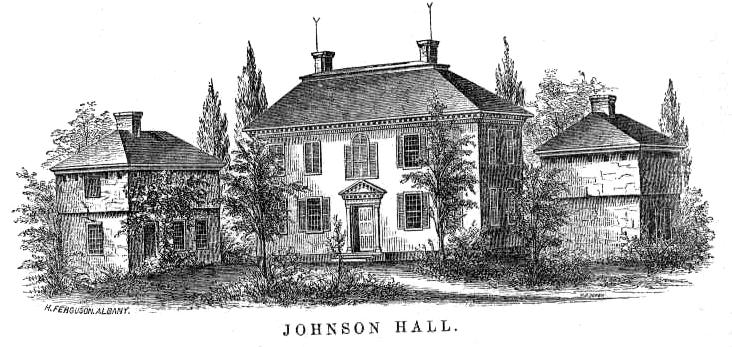Three Rivers
Hudson~Mohawk~Schoharie
History From America's Most Famous Valleys
The
Life and Times of
Sir William Johnson, Bart.,
by William L. Stone
Vol. II
Albany: J. Munsell, 78 State Street, 1865.
APPENDIX No 5

Johnson Hall still stands upon a slight elevation half a mile northward of the village of Johnstown, a little off from the plank road leading to Black river. It was, without doubt, in its day, the most spacious and elegant mansion in the province out of New York City. The timbers in its frame are positively massive, and are as sound at the present day as when first put in. The building is of wood, clapboard to resemble blocks of stone, having on each side detached wings of stone, pierced at the top for musketry, and designed as blockhouses in case of attack from hostile Indian tribes. Although it never experienced a siege, yet it was twice fortified, once by a strong rampart, in 1763, by Sir William Johnson, during the revolt of the western tribes; and again in 1776 by Sir John Johnson previous to his flight into Canada. Upon first entering the house, the visitor is impressed with the feeling of vastness--on such a large scale is everything planned inside. The hall, which runs through the entire building, is fifteen feet wide, and the rooms in both stories are large and lofty; the sides being wainscoted with pine panels and heavy carved work. A broad staircase, lading from the lower to the upper hall, is protected by massive mahogany balustrades, which will bear the marks of the hacking of a hatchet, and by tradition to have been done by Brant when he fled with Sir John in 1776, "to protect the house from the torch of savages who would understand and respect these signs." Tradition however, is a very poor guide to follow; and it is far more probable that it was done by some vandal soldier in the colonial service, who, not being allowed by his superior officer to burn the building, vented his malice in the above manner. When I last visited the Hall in the summer of 1862, the main building was in perfect preservation, although the two block houses were sadly out of repair. Of the garden and nursery, formerly on the south of the Hall, which was the delight of the Baronet and the pride of the surrounding country, not a vestige remains.
Thanks
to James F. Morrison for loaning his book for the purpose of putting it on
the internet.
Copyright © 1998, -- 2003. Berry Enterprises. All rights reserved. All items on the site are copyrighted. While we welcome you to use the information provided on this web site by copying it, or downloading it; this information is copyrighted and not to be reproduced for distribution, sale, or profit.